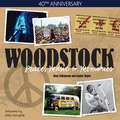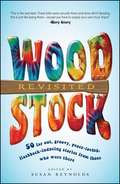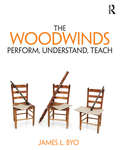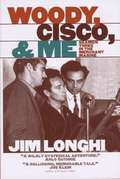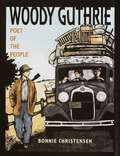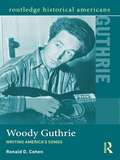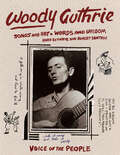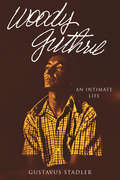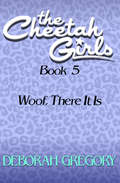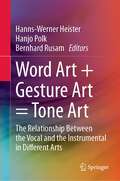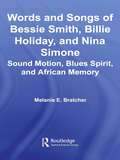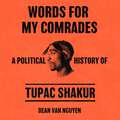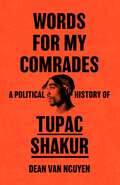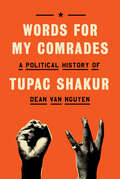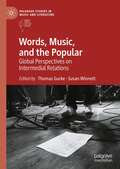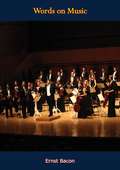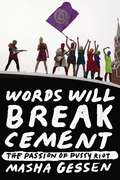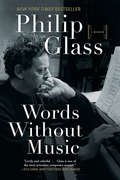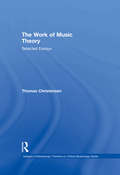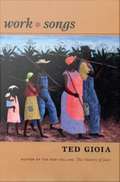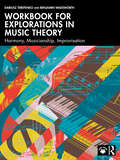- Table View
- List View
Woodstock - Peace, Music & Memories: Peace, Music & Memories
by Brad Littleproud Joanne HagueThree days that changed a generation Woodstock - Peace, Music & Memories tells a story of what Time magazine called "the greatest peaceful event in history." Celebrate the 40th anniversary of this generation-defining moment through the words and pictures of some of the 500,000 people who were at Max Yasgur's farm in 1969. Capturing the spirit of the times with its earthly look and mix of 350 color and black and white photos, Woodstock - Peace, Music & Memories features: Foreword by festival co-creator and promoter Artie Kornfeld Commentary by longtime peace activist and Woodstock insider Wavy Gravy Personal recollections and never-before-seen pictures by the people who were there Special section on Woodstock memorabilia with current values
Woodstock Revisited
by Susan ReynoldsThis collection contains fifty stories written by people who attended the original Woodstock Festival in 1969. Since all the books that preceded it have focused on the musicians, promoters, and staff, this book will be the first one that chronicles the audience's experience in an up close and personal way. This book documents the event itself, but also provides a mesmerizing portrait of America as that tumultuous decade came to a close. It is nostalgic, historical, and a fascinating read that will appeal to all Baby Boomers, their offspring, and anyone who wonders what it was really like--and what became of all those "hippies."
Woodstock Revisited: 50 Far Out, Groovy, Peace-Loving, Flashback-Inducing Stories From Those Who Were There
by Susan ReynoldsThis collection contains fifty stories written by people who attended the original Woodstock Festival in 1969. Since all the books that preceded it have focused on the musicians, promoters, and staff, this book will be the first one that chronicles the audience’s experience in an up close and personal way. This book documents the event itself, but also provides a mesmerizing portrait of America as that tumultuous decade came to a close. It is nostalgic, historical, and a fascinating read that will appeal to all Baby Boomers, their offspring, and anyone who wonders what it was really like—and what became of all those “hippies.”
Woodstock Revisited
by Susan ReynoldsThis collection contains fifty stories written by people who attended the original Woodstock Festival in 1969. Since all the books that preceded it have focused on the musicians, promoters, and staff, this book will be the first one that chronicles the audience's experience in an up close and personal way. This book documents the event itself, but also provides a mesmerizing portrait of America as that tumultuous decade came to a close. It is nostalgic, historical, and a fascinating read that will appeal to all Baby Boomers, their offspring, and anyone who wonders what it was really like'and what became of all those ?hippies. '
The Woodwinds: Perform, Understand, Teach
by James ByoThe Woodwinds: Perform, Understand, Teach provides comprehensive coverage about the woodwind family of musical instruments for prospective instrumental music teachers. What sets this book apart is its focus on how to teach the instruments. Preparing students in the how of teaching is the ultimate goal of the woodwind class and the ultimate goal of this book, which organizes information by its use in teaching beginning instrumentalists. In developing performance and understanding, pre-service teachers are positioned to learn to teach through performance—contrasted with an "old-school" belief that one must first spend much time tediously trying to understand how things work before playing the instruments. The book is organized in three parts: Preliminaries, Teaching the Instruments, and Foundations. Chapters in Teaching the Instruments are organized by instrument (flute, clarinet, saxophone, oboe, bassoon) and, within each instrument, according to how an effective teacher might organize experiences for novice learners. Basic embouchure and air stream are covered first, followed by instrument assembly, then hands and holding. Embouchure coverage returns in greater depth, then articulation, and finally "the mechanism," which includes sections on the instruments of the family, transposition, range, special fingerings, tuning and intonation, and reeds. In Foundations, topics are situated in big picture contexts, calling attention to the broad applicability of information across instruments.
Woody, Cisco, and Me: Seamen Three in the Merchant Marine
by Jim LonghiIn his 1997 memoir, Jim Longhi, who passed away on November 22, 2006, gives the reader a first-hand account of Woody Guthrie and Cisco Houston during those crucial years with anecdotes that no other living person could tell; his action-packed account of their ship's dangerous journeys through mine-infested waters, his memories of their ships being torpedoed, his description of their shore leaves throughout North Africa, Italy, Scotland, England and France, his hilarious "on-board" stories of Woody as the ship's dishwasher, menu artist, totem builder, and impromptu entertainer for the troops. Here we have yet another side of Woody, described as only Jimmy could. Jimmy's more personal observations of Woody as a "bunk-mate" and friend are perhaps even more revealing. He describes one incident where Woody saved his life after a torpedo hit their ship. He also tells us of the day after Woody's four year-old daughter Cathy died in a house fire and Woody's response. The memories go on and on... His writing is so eloquent and descriptive one can't help but think... "what a great movie this would make!" Jim Longhi, has been a prizefighter, ladies' stocking salesman, merchant seaman, lawyer and politician as well as a playwright. During World War II he and Woody, shipped out in the Merchant Marine. Guthrie taught him to sing, play the guitar, and "to be brave." They entertained troops under fire and were torpedoed twice off Italy and Normandy. After the war, Longhi became a lawyer, representing Brooklyn's rank-and-file longshoremen against the gangsters. With three longshoremen murdered, Longhi became the spokesman for the movement. People from all walks of life came to help, Arthur Miller and Elia Kazan among others. Longhi urged them to make the movie "On the Waterfront" for which Longhi conceived the original idea. Thereafter, Longhi wrote his own play about the waterfront called "Two Fingers of Pride," and gave Steve McQueen his first job. Longhi's second play, "Climb the Greased Pole," was produced in London's Mermaid Theater, starring Sir Bernard Miles. "The Lincoln Mask," which was performed this year off Broadway. His latest play "The Lantern," a play about Lincoln, was just finished.
Woody Guthrie: Poet of the People
by Bonnie ChristensenWoody Guthrie spent his life putting into words and music what the rest of America was thinking. He roamed from coast to coast and captured the despair of those displaced by the Great Depression and the dust bowl, eulogized workers, and celebrated the great natural beauty of America. This is an introductory biography presented as a picture book with a brief lyrical text and powerful, hand-tinted, woodcut-like illustrations. It includes the complete lyrics to “This Land Is Your Land” and excerpts from his other songs. A book for all ages, it makes this talented and tragic man accessible to young children and will please his older folksinging fans with its stunning art.
Woody Guthrie: Writing America's Songs (Routledge Historical Americans)
by Ronald D. CohenWoody Guthrie is the most famous and influential folk music composer and performer in the history of the United States. His most popular song, "This Land is Your Land" has become the country's unofficial national anthem, known to every school child since the 1960s. His influence exceeded the realm of American music, reaching American politics. Guthrie’s music became the soundtrack to the Great Depression, and iconic of the Dust Bowl migrants. Guthrie and his music came to represent those disenfranchised people who remained committed to making better lives for themselves through the promise of the American Dream. Here, in a short, accessible biography, bolstered with primary documents, including letters, autobiographical excerpts, and reflections by Pete Seeger, Cohen introduces Guthrie’s life and music influence to students of American history and culture.
Woody Guthrie: Songs and Art * Words and Wisdom (American Music Masters Ser.)
by Nora Guthrie Robert Santelli"You can listen to his songs and learn how to live." —Bob Dylan, on Woody Guthrie The timely, passionate, and humanely political work of America's greatest folk singer and songwriter is presented through his own words and art—curated by Woody's daughter—in this essential self-portrait, including never-before-published lyrics and personal writing, and testimony from contemporary writers and musicians on his powerful relevance today. Winner of the Deems Taylor/Virgil Thomson Book Award for Outstanding Pop Music Publication Named one of the Best Music Books of 2021 by The Current, Minnesota Public RadioWoody Guthrie and his passionate social politics are as crucial today as they have ever been. A powerful voice for justice, and the author of more than 3,000 songs (including "This Land is Your Land"), he was also a poet, painter, illustrator, novelist, journal keeper, and profuse letter writer. Curated by his daughter Nora and award-winning music historian Robert Santelli, this fresh, intimate, and beautifully designed book thematically reveals Woody's story through his own personal writings, lyrics, and artwork, urgently bringing his voice to life. Featuring never-before-published lyrics to some of his greatest songs, personal diary entries, doodles, quips and jokes, and piercing insights on his politics and justice, this is an undeniable and important celebration of Woody's vibrant life's work. Created to be enjoyed by all—those interested in folk music or those interested in Woody's thoughts on Life in all its aspects, from Politics and Spirituality to Love and Family.ONE OF THE MOST INFLUENTIAL SONGWRITERS IN AMERICAN MUSIC HISTORY: Woody Guthrie has had a profound impact on American musicians, writers, politicians (and the everyman who found solace and kinship in Guthrie's writings and political beliefs), who have been shaped by his music and activism—namely the great founding father of songwriting himself, Bob Dylan, for whom he was a mentor, as powerfully depicted in the biopic A Complete Unknown starring Timothée Chalamet as Dylan and Scoot McNairy as Guthrie. Others who have named Guthrie as a major influence include Bruce Springsteen, Johnny Cash, Pete Seeger, John Mellencamp, Billy Bragg, Joe Strummer, and Jerry Garcia, to name just a few. RARE ARCHIVAL MATERIAL: This is Woody's life told primarily in his own words, with never-before-published handwritten lyrics, artwork, journals, and much more. WORDS OF WISDOM RELEVANT TODAY: Woody Guthrie's lyrics and writings carry pointed relevance to our world today—he wrote powerfully about economic inequality, immigration reform, fascism, war, corruption from capitalism gone wild, patriotism, and environmentalism—not to mention spirituality of all kinds, love, and family. EXCLUSIVE CONTRIBUTORS: Includes new writing about Woody and his music by Chuck D., Ani DiFranco, Douglas Brinkley, Jeff Daniels, Arlo Guthrie, and Rosanne Cash.Perfect for: Music and Americana lovers Musicians and artists Political activists and historians Fans of Dylan Goes Electric! by Elijah Wald
Woody Guthrie: A Life
by Joe KleinBiography of the singer, songmaker and restless spirit who defined the American character for a generation.
Woody Guthrie: An Intimate Life
by Gustavus StadlerDismantles the Woody Guthrie we have been taught--the rough-and-ready ramblin' man--to reveal an artist who discovered how intimacy is crucial for political struggleWoody Guthrie is often mythologized as the classic American "ramblin' man," a real-life Steinbeckian folk hero who fought for working-class interests and inspired Bob Dylan. Biographers and fans frame him as a foe of fascism and focus on his politically charged folk songs. What's left unexamined is how the bulk of Guthrie's work--most of which is unpublished or little known--delves into the importance of intimacy in his personal and political life. Featuring an insert with personal photos of Guthrie's family and previously unknown paintings, Woody Guthrie: An Intimate Life is a fresh and contemporary analysis of the overlapping influences of sexuality, politics, and disability on the art and mind of an American folk icon.Part biography, part cultural history of the Left, Woody Guthrie offers a stunning revelation about America's quintessential folk legend, who serves as a guiding light for leftist movements today. In his close relationship with dancer Marjorie Mazia, Guthrie discovered a restorative way of thinking about the body, which provided a salve for the trauma of his childhood and the slowly debilitating effects of Huntington's disease. Rejecting bodily shame and embracing the power of sexuality, he came to believe that intimacy was the linchpin for political struggle. By closely connecting to others, society could combat the customary emotional states of capitalist cultures: loneliness and isolation. Using intimacy as one's weapon, Guthrie believed we could fight fascism's seductive call.
Woof, There It Is: Woof, There It Is (The Cheetah Girls #5)
by Deborah GregoryThe hip, contemporary paperback series for black girls continues, featuring a singing group of five feisty teens.
Word Art + Gesture Art = Tone Art: The Relationship Between the Vocal and the Instrumental in Different Arts
by Hanns-Werner Heister Hanjo Polk Bernhard RusamThis book offers a truly interdisciplinary discussion on the relationship between the vocal and the instrumental in music and other arts and in everyday communication alike. Presenting an in-depth systematical and historical analysis of the evolution of word and gesture art, it gives extensive information on the anthropological, biological, and physiological influences and interactions in music and beyond. The book gives a unique definition of the genuinely vocal and instrumental from their generative deep structure: They derive from and are determined in their production by the duality of voice and hands, and in terms of product as the tone or ‘tonal’ on the one hand, and the percussive, that is noise plus rhythm, on the other. This book succeeds in bringing together perspectives from art, and from natural and social sciences, merging them to offer new explanations about the relationship between the vocal and instrumental, and eventually about the origins of music, arts, and language. It offers new perspectives on the intertwining between the vocal and the instrumental, specifically in the context of the expressions of human languages. At the same time, this book aims at clarifying and explaining the role of words and gestures in different contexts, such as society and communication, education, and arts.
Words and Songs of Bessie Smith, Billie Holiday, and Nina Simone: Sound Motion, Blues Spirit, and African Memory (Studies in African American History and Culture)
by Melanie E. BratcherThis book explores the relationship between three African American women's dance-art-music sensibilities within the context of a Pan African aesthetic. Its purpose is three-fold: to show commonalities between Bessie Smith, Billie Holiday and Nina Simone's lives and original compositions; to codify, examine and evaluate their selected song performances in accordance with the Pan African aesthetic "Nzuri theory/model;" and to illuminate the vast sources of transformational values that aesthetic analysis of African American song performance can foster. Following concordant procedures and principles of Afrocentricity, the study focuses on Smith, Holiday and Simone's performances as part of a whole African artistic and cultural value system. The goal of the Afrocentric methodological structure is to locate relevant African dynamics in songs and to promote knowledge for cultural transformation and continuity. Its use in this study provides meta-criteria for analyzing African American music, which the author has used to uniquely argue connections between African cultural memory and African-derived cultural expression.
Words for My Comrades: A Political History of Tupac Shakur
by Dean Van NguyenBefore his murder at twenty-five, Tupac Shakur rose to staggering artistic heights as the pre-eminent storyteller of the 90s, building, in the process, one of the most iconic public personas of the last half century. He recorded several platinum-selling albums, starred in major films and became an activist and political hero known the world over.In this cultural history and brilliantly researched biography, Dean Van Nguyen reckons with Tupac's coming of age, fame and influence and how the political machinations that shaped him as a boy have since buoyed his legacy as a revolutionary following the George Floyd uprising. Words for My Comrades crucially engages with the influence of Tupac's mother, Afeni, whose role in the Black Panther Party, with its dedication to dismantling American imperialism and police brutality, informed Tupac's art. Tupac's childhood as a son of the Panthers, coupled with the influence of his militant stepfather Mutulu Shakur, became his own riveting code of ethics that helped listeners reckon with America's inherent injustices.Drawing upon conversations with the people who bore witness - from Panther veterans and other committed Marxist revolutionaries of 1970s America, to good friends and close collaborators of the rapper himself - Van Nguyen demonstrates how Tupac became one of the most enduring musical legends in hip-hop history and how intimately his name is threaded with the legacy of Black Panther politics. Words for My Comrades is the story of how the energy of the Black political movement was subsumed by culture and how America produced, in Tupac and Afeni, two of its most iconic, enduring revolutionaries.
Words for My Comrades: A Political History of Tupac Shakur
by Dean Van NguyenBefore his murder at twenty-five, Tupac Shakur rose to staggering artistic heights as the pre-eminent storyteller of the 90s, building, in the process, one of the most iconic public personas of the last half century. He recorded several platinum-selling albums, starred in major films and became an activist and political hero known the world over.In this cultural history and brilliantly researched biography, Dean Van Nguyen reckons with Tupac's coming of age, fame and influence and how the political machinations that shaped him as a boy have since buoyed his legacy as a revolutionary following the George Floyd uprising. Words for My Comrades crucially engages with the influence of Tupac's mother, Afeni, whose role in the Black Panther Party, with its dedication to dismantling American imperialism and police brutality, informed Tupac's art. Tupac's childhood as a son of the Panthers, coupled with the influence of his militant stepfather Mutulu Shakur, became his own riveting code of ethics that helped listeners reckon with America's inherent injustices.Drawing upon conversations with the people who bore witness - from Panther veterans and other committed Marxist revolutionaries of 1970s America, to good friends and close collaborators of the rapper himself - Van Nguyen demonstrates how Tupac became one of the most enduring musical legends in hip-hop history and how intimately his name is threaded with the legacy of Black Panther politics. Words for My Comrades is the story of how the energy of the Black political movement was subsumed by culture and how America produced, in Tupac and Afeni, two of its most iconic, enduring revolutionaries.
Words for My Comrades: A Political History of Tupac Shakur
by Dean Van NguyenFrom Pitchfork and Guardian contributor Dean Van Nguyen comes a revelatory history of Tupac beyond his musical legend, as a radical son of the Black Panther Party whose political legacy still resonates today.Before his murder at age twenty-five, Tupac Shakur rose to staggering artistic heights as the preeminent storyteller of the 1990s, building, in the process, one of the most iconic public personas of the last half century. He recorded no fewer than ten platinum albums, starred in major films, and became an activist and political hero known the world over. In this cultural history, journalist Van Nguyen reckons with Tupac&’s coming of age, fame, and cultural capital, and how the political machinations that shaped him as a boy have since buoyed his legacy as a revolutionary following the George Floyd uprisings. Words for My Comrades engages—crucially—with the influence of Tupac&’s mother, Afeni, whose role in the Black Panther Party and dedication to dismantling American imperialism and combating police brutality informed Tupac&’s art. Tupac&’s childhood as a son of the Panthers, coupled with the influence of his stepfather&’s Marxist beliefs, informed his own riveting code of ethics that helped audiences grapple with America&’s inherent injustices.Using oral histories from conversations with the people who directly witnessed Tupac&’s life and career, many of whom were interviewed for the first time here—from Panther elder Aaron Dixon, to music video director Stephen Ashley Blake, to friends and contemporaries of Tupac&’s mother—Van Nguyen demonstrates how Tupac became one of the most enduring musical legends in hip-hop history, and how intimately his name is threaded with the legacy of Black Panther politics.Van Nguyen reveals how Tupac and Afeni each championed the disenfranchised in distinct ways, and how their mother-son bond charts a narrative of the last fifty years of revolutionary Black American politics. Words for My Comrades is the story of how the energy of the Black political movement was subsumed by culture, and how America produced two of its most iconic, enduring revolutionaries.
Words, Music, and the Popular: Global Perspectives on Intermedial Relations (Palgrave Studies in Music and Literature)
by Susan Winnett Thomas GurkeWords, Music, and the Popular: Global Perspectives on Intermedial Relations opens up the notion of the popular, drawing useful links between wide-ranging aspects of popular culture, through the lens of the interaction between words and music. This collection of essays explores the relation of words and music to issues of the popular. It asks: What is popularity or ‘the’ popular and what role(s) does music play in it? What is the function of the popular, and is ‘pop’ a system? How can popularity be explained in certain historical and political contexts? How do class, gender, race, and ethnicity contribute to and complicate an understanding of the ‘popular’? What of the popularity of verbal art forms? How do they interact with music at particular times and throughout different media?
Words of a Goat Princess
by Jessie ReyezA moving poetic debut from a talented artist, Words of a Goat Princess is everything you love about singer/songwriter Jessie Reyez—her rawness, her love affair with the ugly truths of humanity, and so much more.Words of a Goat Princess is the debut poetry collection about life’s struggle and triumphs from Grammy-nominated and JUNO-award winning songwriter Jessie Reyez.With the authenticity and heartbreaking relatability that her fans know and love her for, Reyez brings the breadth of her lived experience to the page as few recording artists can. At times ethereal and visceral, these 43 poems are carefully painted moments that expertly explore love, loss, and identity with an artistry that leaps off the page with every turn.Through this collection of poems and stories, Jessie Reyez shows that she is more than a pop performer, she is a true artist whose star knows no limits.
Words on Music
by Ernst BaconA deep and thoughtful contemplation on music by and acclaimed expert.“Ernst Bacon, composer, pianist, and conductor, was born on May 26, 1898. He was the son of Maria von Rosthorn Bacon, a Viennese-trained musician, and Dr. Charles S. Bacon. He studied at Northwestern University, the University of Chicago, and the University of California, and also privately with Alexander Raab, Glenn Dillard Gunn, Ernest Bloch, and Karl Weigl. Among the numerous awards and grants he received are the Bispham Award, commissions from the Ditson Fund and the League of Composers, a Pulitzer Traveling Scholarship in Music, three Guggenheim Fellowships.A multi-faceted musician, Bacon composed and conducted symphonies, operas, piano concertos, musical theater pieces, ensemble and solo instrumental pieces, and vocal works. In addition, he performed as a pianist in Europe and America, and he conducted the WPA orchestra in California from 1935 to 1937. He taught and was an administrator at the Eastman School of Music of the University of Rochester (1926-27), Syracuse University’s music department (1945-47), and Converse College in South Carolina (1938-45).He distinguished himself as a writer with such works as Notes on the Piano, The Honor of Music, and Words on Music. In Our Musical Idioms, Bacon presented a new theory of scale models derived from diatonic scales. He was also music critic for The Argonaut, the weekly publication of Converse College. Ernst Bacon was respected as a philosopher by a close circle of friends who were fortunate enough to see his unpublished writings, [e.g. Imaginary Dialogues and his many poems]. He was a highly opinionated man, a fact evident from his large volume of letters to the editors of several major and not so major serials.Ernst Bacon married four times and had six children. He died on March 16, 1990 in Orinda, California.”—Library of Congress
Words Will Break Cement
by Masha GessenThe heroic story of Pussy Riot, who resurrected the power of truth in a society built on lies On February 21, 2012, five young women entered the Cathedral of Christ the Savior in Moscow. In neon-colored dresses, tights, and balaclavas, they performed a "punk prayer" beseeching the "Mother of God" to "get rid of Putin." They were quickly shut down by security, and in the weeks and months that followed, three of the women were arrested and tried, and two were sentenced to a remote prison colony. But the incident captured international headlines, and footage of it went viral. People across the globe recognized not only a fierce act of political confrontation but also an inspired work of art that, in a time and place saturated with lies, found a new way to speak the truth. Masha Gessen's riveting account tells how such a phenomenon came about. Drawing on her exclusive, extensive access to the members of Pussy Riot and their families and associates, she reconstructs the fascinating personal journeys that transformed a group of young women into artists with a shared vision, gave them the courage and imagination to express it unforgettably, and endowed them with the strength to endure the devastating loneliness and isolation that have been the price of their triumph.
Words Without Music: A Memoir
by Philip GlassThe long-awaited memoir by "the most prolific and popular of all contemporary composers" (New York Times). A world-renowned composer of symphonies, operas, and film scores, Philip Glass has, almost single-handedly, crafted the dominant sound of late-twentieth-century classical music. Yet here in Words Without Music, he creates an entirely new and unexpected voice, that of a born storyteller and an acutely insightful chronicler, whose behind-the-scenes recollections allow readers to experience those moments of creative fusion when life so magically merged with art. "If you go to New York City to study music, you'll end up like your uncle Henry," Glass's mother warned her incautious and curious nineteen-year-old son. It was the early summer of 1956, and Ida Glass was concerned that her precocious Philip, already a graduate of the University of Chicago, would end up an itinerant musician, playing in vaudeville houses and dance halls all over the country, just like his cigar-smoking, bantamweight uncle. One could hardly blame Mrs. Glass for worrying that her teenage son would end up as a musical vagabond after initially failing to get into Juilliard. Yet, the transformation of a young man from budding musical prodigy to world-renowned composer is the story of this commanding memoir. From his childhood in post-World War II Baltimore to his student days in Chicago, at Juilliard, and his first journey to Paris, where he studied under the formidable Nadia Boulanger, Glass movingly recalls his early mentors, while reconstructing the places that helped shape his artistic consciousness. From a life-changing trip to India, where he met with gurus and first learned of Gandhi's Salt March, to the gritty streets of New York in the 1970s, where the composer returned, working day jobs as a furniture mover, cabbie, and an unlicensed plumber, Glass leads the life of a Parisian bohemian artist, only now transported to late-twentieth-century America. Yet even after Glass's talent was first widely recognized with the sensational premiere of Einstein on the Beach in 1976, even after he stopped renewing his hack license and gained international recognition for operatic works like Satyagraha, Orphée, and Akhnaten, the son of a Baltimore record store owner never abandoned his earliest universal ideals throughout his memorable collaborations with Allen Ginsberg, Ravi Shankar, Robert Wilson, Doris Lessing, Martin Scorsese, and many others, all of the highest artistic order. Few major composers are celebrated as writers, but Philip Glass, in this loving and slyly humorous autobiography, breaks across genres and re-creates, here in words, the thrill that results from artistic creation. Words Without Music ultimately affirms the power of music to change the world.
The Work of Music Theory: Selected Essays (Ashgate Contemporary Thinkers On Critical Musicology Ser.)
by Thomas ChristensenThis collection brings together an anthology of articles by Thomas Christensen, one of the leading historians of music theory active today. Published over the span of the past 25 years, the selected articles provide a historical conspectus about a range of vital topics in the history of music theory, focusing in particular upon writings from the seventeenth and eighteenth centuries. Christensen examines a variety of theorists and their arguments within the intellectual and musical contexts of their time, in the process highlighting the diverse and idiosyncratic nature of the discipline of music theory itself. In the first section of the book Christensen offers general reflections on the meaning and interpretation of historical music theories, with especial attention paid to their value for music theorists today. The second section of the book contains a number of articles that consider the catalytic role of the thorough bass in the development of harmonic theory during the seventeenth and eighteenth centuries. In the final two sections of the anthology, focus turns to the writings of several individual music theorists, including Marin Mersenne, Seth Calvisius, Johann Mattheson, Johann Nicolaus Bach, Denis Diderot and Johann Nichelmann. The volume includes essays from hard-to-find publications as well as newly-translated material and the articles are prefaced by a new, wide-ranging autobiographical essay by the author that offers a broad re-assessment of his historical project. This book is essential reading for music theorists and seventeenth- and eighteenth-century musicologists.
Work Songs
by Ted GioiaAll societies have relied on music to transform the experience of work. Song accompanied the farmer's labors, calmed the herder's flock, and set in motion the spinner's wheel. Today this tradition continues. Music blares on the shop floor; song accompanies transactions in the retail store; the radio keeps the trucker going on the long-distance haul. Now Ted Gioia, author of several acclaimed books on the history of jazz, tells the story of work songs from prehistoric times to the present. Vocation by vocation, Gioia focuses attention on the rhythms and melodies that have attended tasks such as the cultivation of crops, the raising and lowering of sails, the swinging of hammers, the felling of trees. In an engaging, conversational writing style, he synthesizes a breathtaking amount of material, not only from songbooks and recordings but also from travel literature, historical accounts, slave narratives, folklore, labor union writings, and more. He draws on all of these to describe how workers in societies around the world have used music to increase efficiency, measure time, relay commands, maintain focus, and alleviate drudgery. At the same time, Gioia emphasizes how work songs often soar beyond utilitarian functions. The heart-wringing laments of the prison chain gang, the sailor's shanties, the lumberjack's ballads, the field hollers and corn-shucking songs of the American South, the pearl-diving songs of the Persian Gulf, the rich mbube a cappella singing of South African miners: Who can listen to these and other songs borne of toil and hard labor without feeling their sweep and power? Ultimately, Work Songs, like its companion volume Healing Songs, is an impassioned tribute to the extraordinary capacity of music to enter into day-to-day lives, to address humanity's deepest concerns and most heartfelt needs.
Workbook for Explorations in Music Theory: Harmony, Musicianship, Improvisation
by Dariusz Terefenko Benjamin WadsworthExplorations in Music Theory: Harmony, Musicianship, Improvisation offers an innovative learning approach to music theory, centered on instrumental skills, improvisation, and composition. Providing a comprehensive textbook to support music theory curricula, along with an accompanying workbook, it includes extensive performance-based exercises in each chapter, alongside written theory and analysis. This book teaches harmony as a series of historical practices, each with different advantages and disadvantages. Classes are empowered to critically compare these practices and adopt those that they find most effective. Designed to support multiple learning modalities, and incorporating repertoire from a diverse array of composers, this book offers instructors and students a comprehensive and engaging foundation in music theory.Features of this book include:· Modular lessons centered on inquiry-driven pedagogy, offering flexibility· Lesson difficulty is marked to allow instructors to easily organize their course· A wide variety of exercises and practice tasks incorporated throughout the chapters· Improvisation Labs allow students to practice concepts through improvisation· Historical Minutes introduce students to historical theorists and enable them to understand music theory as a living practice· Composer Spotlights highlight the stories of composers whose work is featured in the chapter, bringing forward underrepresented composers· Explore Online features provide additional exercises and coverage of advanced topics through an accompanying online resourceA flexible, modular organization allows the book to be used in a variety of course structures, accommodating a wide variety of schools. Enhancing improvisation and composition skills, introducing historical perspectives, incorporating diverse repertoire, and enabling students to better connect theory concepts with practical applications, this text provides a new and effective way to teach harmony.This accompanying Workbook offers exercises to accompany each chapter in the book. Divided into warmup and homework sections, the exercises in the Workbook provide additional practice with the skills addressed in the textbook through a range of approaches, including writing, composition, and identification.
